Composite proton conducting electrolyte with improved additives for fuel cells
a proton-conducting electrolyte and additive technology, applied in the direction of transportation hydrogen technology, electrical generators, sustainable buildings, etc., can solve the problems of fuel cell failure, membrane degradation, and performance degradation, and achieve the effect of durable benefits
- Summary
- Abstract
- Description
- Claims
- Application Information
AI Technical Summary
Benefits of technology
Problems solved by technology
Method used
Image
Examples
examples
[0061]Several polymer membrane samples comprising improved additives of the invention were prepared as described below. In addition, several polymer membrane samples were prepared with other additives for comparative purposes.
[0062]The membrane samples were all cast from dispersions of Nafion® perfluorosulfonic acid (PFSA) ionomer with equivalent weight EW875. For the membrane samples comprising the additives, appropriate additives or additive components were added into the ionomer dispersion while stirring to obtain transparent ionomer dispersions comprising the additives. The obtained transparent solutions were then degassed, and cast on a carrier. After evaporating the solvent off, the obtained membrane samples were annealed at 150° C. for 1 hour.
[0063]The following inventive samples were prepared:
Inventive Example C1
[0064]In a vial, 0.0207 grams of bathophenanthroline (1 weight % of PFSA), 0.0065 grams of Ce(NO3)3.6H2O (molar ratios of bathophenanthroline to Ce3+ was 4:1) and 9....
example c2
Inventive Example C2
[0065]In a vial, 0.0208 grams of bathophenanthroline (1 weight % of PFSA), 0.0018 grams of Mn02 (molar ratios of bathophenanthroline to Mn was 4:1) and 9.36 grams of PFSA ionomer dispersion (solids concentration 22%) were stirred overnight at 50° C. A (Mn)(bathophenanthroline) additive (hereinafter denoted as C2) was formed in solution and a membrane sample comprising 1% of this C2 additive was cast from the solution. The possible chemical structures of the complexes in the C2 additive are shown in FIG. 2b.
##ventive example c3
Inventive Example C3
[0066]In a vial, 0.0138 grams of 1,10-phenanthroline-5-amino (0.5 weight % of PFSA), 0.0015 grams of MnO2 (molar ratios of 1,10-phenanthroline-5-amino to Mn was 4:1) and 12.55 g PFSA ionomer dispersion (solids concentration is 22%) were stirred overnight at 50° C. A (Mn)(1,10-phenanthroline-5-amino) additive (hereinafter denoted as C3) was formed in solution and a membrane sample comprising 0.5% of this C3 additive was cast from the solution. The possible chemical structures of the complexes in the C3 additive are shown in FIG. 2c.
PUM
| Property | Measurement | Unit |
|---|---|---|
| molar ratio | aaaaa | aaaaa |
| active area | aaaaa | aaaaa |
| current density | aaaaa | aaaaa |
Abstract
Description
Claims
Application Information
 Login to View More
Login to View More - R&D
- Intellectual Property
- Life Sciences
- Materials
- Tech Scout
- Unparalleled Data Quality
- Higher Quality Content
- 60% Fewer Hallucinations
Browse by: Latest US Patents, China's latest patents, Technical Efficacy Thesaurus, Application Domain, Technology Topic, Popular Technical Reports.
© 2025 PatSnap. All rights reserved.Legal|Privacy policy|Modern Slavery Act Transparency Statement|Sitemap|About US| Contact US: help@patsnap.com



